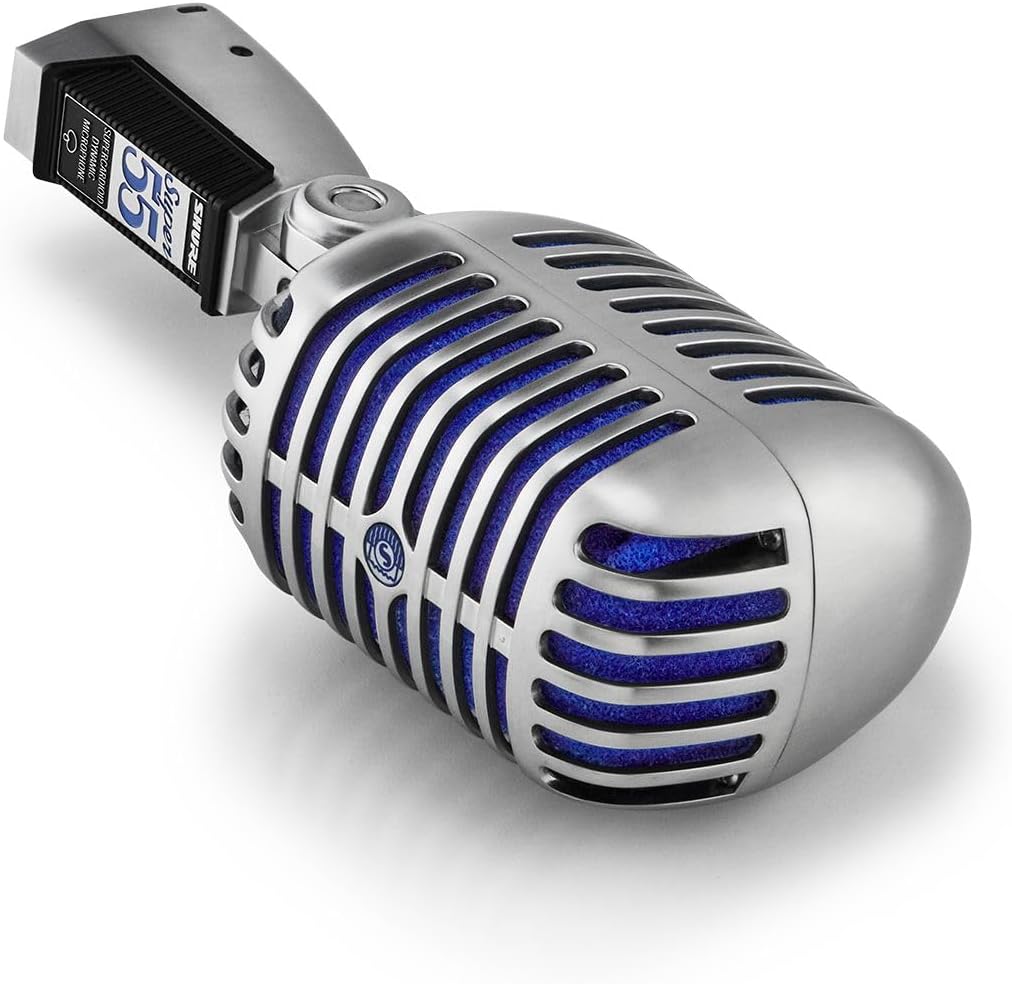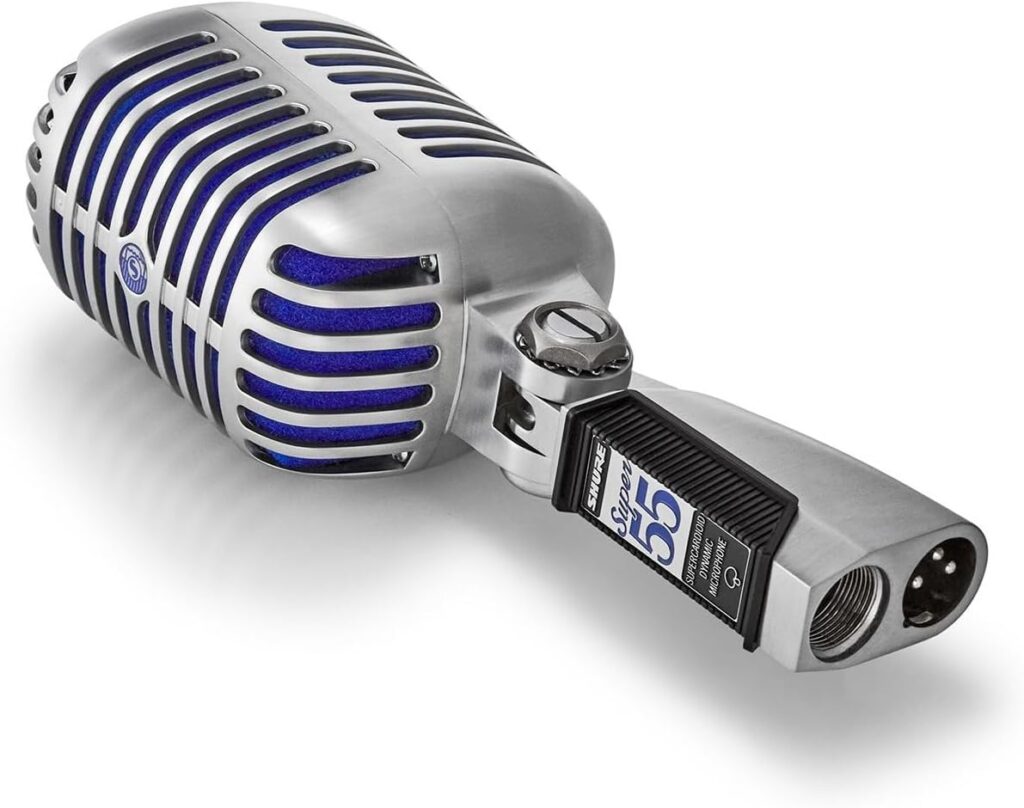Shure Super 55 Review
When it comes to microphones that blend vintage aesthetics with contemporary functionality, few models stand out as prominently as the Shure Super 55. Often dubbed the “Elvis mic” due to its iconic look reminiscent of the 1950s rock ‘n’ roll era, the Super 55 is a dynamic vocal microphone that carries forward the legacy of its predecessor, the Shure 55SH, while incorporating modern upgrades. Whether you’re a singer, podcaster, voice-over artist, or live performer, the Super 55 promises to deliver both style and substance. But does it live up to the hype? In this review, we’ll explore its design, sound quality, build, versatility, and overall value to help you decide if it’s the right microphone for your needs.
Shure Super 55 Review
Before diving into the Super 55 itself, it’s worth understanding its roots. Shure has been a titan in the audio industry since the 1930s, and the original 55 Unidyne microphone, introduced in 1939, was a groundbreaking piece of equipment. It was the world’s first single-element unidirectional dynamic microphone, offering superior sound isolation and a distinctive Art Deco design. Over the decades, the 55 series evolved into the 55SH, a staple on stages worldwide, famously associated with legends like Elvis Presley and Billie Holiday.
The Super 55, released as an upgrade to the 55SH, retains that retro charm but enhances the internal components for better performance in modern recording and live settings. Launched alongside the Shure 55SH Series II (a more direct recreation of the original), the Super 55 aims to bridge the gap between nostalgia and cutting-edge audio engineering. So, how does it fare in practice? Let’s break it down.
Design and Build Quality
The first thing you notice about the Shure Super 55 is its striking appearance. With its satin chrome-plated die-cast metal body and bold red foam windscreen, it’s a microphone that demands attention. The design screams mid-century cool, evoking images of smoky jazz clubs and vintage radio broadcasts. It’s not just a tool—it’s a statement piece. Weighing in at 1.45 pounds (656 grams), it feels substantial in hand, exuding durability and quality craftsmanship.
The Super 55’s construction is rugged, built to withstand the rigors of live performance. The metal grille and casing are tough enough to handle accidental drops or the occasional enthusiastic mic swing. The integrated stand mount is sturdy and adjustable, allowing for easy positioning on a mic stand or desk setup. Unlike some modern microphones that prioritize lightweight materials, the Super 55 leans into its heft, which adds to its premium feel.
One minor critique of the design is its size. Measuring approximately 7.4 inches long and 2.2 inches wide at its broadest point, it’s not the most compact microphone. For performers with smaller hands or those who prefer a slimmer profile, it might feel a bit unwieldy during extended use. However, this is a small trade-off for its aesthetic appeal and robust build.
Sound Quality
At its core, the Shure Super 55 is a supercardioid dynamic microphone, meaning it’s designed to capture sound primarily from the front while rejecting noise from the sides and rear. This polar pattern makes it an excellent choice for live settings where stage bleed from monitors or instruments could otherwise muddy the mix. But how does it sound?
The Super 55 delivers a warm, rich tone with a tailored frequency response (60 Hz to 17 kHz) that’s optimized for vocals. It emphasizes the midrange, giving voices a full, present quality that cuts through without sounding harsh. There’s a slight boost in the upper mids (around 3-6 kHz), which enhances clarity and articulation—perfect for singers who want their lyrics to shine or podcasters aiming for intelligible speech.
Low-end response is solid but controlled, avoiding the boomy bass that can plague some dynamic mics. This makes it less ideal for capturing deep, resonant tones (think spoken-word artists with Barry White-esque voices), but it’s a boon for preventing muddiness in live environments. The high-end rolls off gently past 10 kHz, which sacrifices some airiness but reduces sibilance and feedback—a fair compromise for its intended use.
Compared to its sibling, the 55SH Series II, the Super 55 offers a more refined sound. The 55SH has a slightly flatter response and a more pronounced proximity effect (bass boost when close to the source), which can be great for dramatic vocal effects but less forgiving in uncontrolled settings. The Super 55, by contrast, feels tighter and more polished, reflecting its modern engineering tweaks.
Performance in Different Scenarios
Live Performance
On stage, the Super 55 truly shines. Its supercardioid pattern excels at isolating the vocalist’s voice, even in noisy environments. During a recent test at a small venue with a full band—drums, guitars, and all—the mic rejected bleed from the monitors admirably, delivering clean vocal output to the PA system. Feedback resistance is impressive, though not infallible; careful monitor placement is still required, especially at high volumes.
The mic’s dynamic nature means it doesn’t require phantom power, making it plug-and-play for most live setups. Its output is robust enough to pair with any decent mixer or PA without needing excessive gain, though it’s worth noting that dynamic mics like this generally produce a lower signal than condensers, so a good preamp helps.
Studio Recording
In the studio, the Super 55 holds its own but isn’t a first-choice replacement for a condenser mic. Its dynamic design and tailored response make it best suited for vocals with character—think rock, blues, or retro pop—rather than pristine, neutral recordings. I recorded a vocal track with it alongside a Shure SM7B (another dynamic mic favorite) and found the Super 55 imparted a livelier, more “in-your-face” quality, while the SM7B was smoother and more versatile. For podcasters or voice-over artists wanting a vintage vibe, it’s a fantastic option, especially with a pop filter to tame plosives.
Broadcasting and Streaming
The Super 55 has also found a niche among streamers and content creators who value its visual flair. Paired with a decent audio interface, it delivers professional-grade sound for Twitch streams or YouTube videos. Its directional pickup minimizes room noise, though it’s not as forgiving as a condenser mic for capturing subtle nuances from a distance.
How It Compares to the Competition
To put the Super 55 in context, let’s compare it to a few notable alternatives:
- Shure SM58 ($99): The industry-standard vocal mic is cheaper, lighter, and more versatile but lacks the Super 55’s style and refined sound. The SM58’s cardioid pattern is less directional, making it more prone to bleed.
- Shure 55SH Series II ($199): A closer sibling, the 55SH offers a similar look with a rawer, vintage sound. It’s less polished than the Super 55 and better for purists chasing that classic tone.
- Electro-Voice RE20 ($450): A premium dynamic mic, the RE20 outclasses the Super 55 in versatility and studio performance but costs nearly twice as much and lacks the retro aesthetic.
- Audio-Technica AT2020 ($99): A budget condenser mic, the AT2020 offers more detail for studio work but requires phantom power and is less suited for live use.
The Super 55 sits in a sweet spot for those who want a blend of style, vocal focus, and live-ready performance, though it’s not the most budget-friendly or all-purpose option..
Final Thoughts
The Shure Super 55 is a triumph of form and function. It’s not the most versatile microphone on the market, nor is it the cheapest, but it doesn’t aim to be. This is a mic for those who want to stand out—visually and sonically. Singers in rock, jazz, or retro genres will love its punchy, warm sound, while podcasters and streamers can leverage its aesthetic to elevate their setup. It’s built to last, performs reliably on stage, and brings a touch of nostalgia to any project.
If you’re after a do-everything studio workhorse or a budget-friendly option, the Super 55 might not be for you. But if you value craftsmanship, character, and a microphone that doubles as a piece of art, it’s hard to go wrong with this iconic beauty. In a world of sleek, utilitarian gear, the Shure Super 55 proves that sometimes, style is just as important as substance.




